Zoe Kourtzi
Brain Foundation Models with Hypergraph Dynamic Adapter for Brain Disease Analysis
May 01, 2025Abstract:Brain diseases, such as Alzheimer's disease and brain tumors, present profound challenges due to their complexity and societal impact. Recent advancements in brain foundation models have shown significant promise in addressing a range of brain-related tasks. However, current brain foundation models are limited by task and data homogeneity, restricted generalization beyond segmentation or classification, and inefficient adaptation to diverse clinical tasks. In this work, we propose SAM-Brain3D, a brain-specific foundation model trained on over 66,000 brain image-label pairs across 14 MRI sub-modalities, and Hypergraph Dynamic Adapter (HyDA), a lightweight adapter for efficient and effective downstream adaptation. SAM-Brain3D captures detailed brain-specific anatomical and modality priors for segmenting diverse brain targets and broader downstream tasks. HyDA leverages hypergraphs to fuse complementary multi-modal data and dynamically generate patient-specific convolutional kernels for multi-scale feature fusion and personalized patient-wise adaptation. Together, our framework excels across a broad spectrum of brain disease segmentation and classification tasks. Extensive experiments demonstrate that our method consistently outperforms existing state-of-the-art approaches, offering a new paradigm for brain disease analysis through multi-modal, multi-scale, and dynamic foundation modeling.
Bilevel Hypergraph Networks for Multi-Modal Alzheimer's Diagnosis
Mar 19, 2024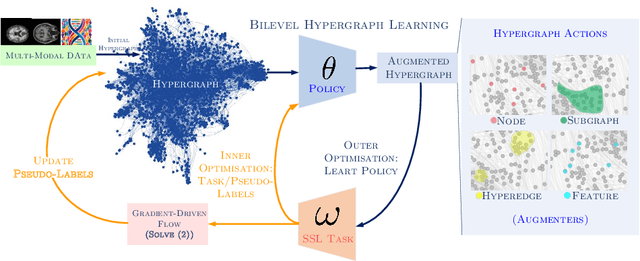
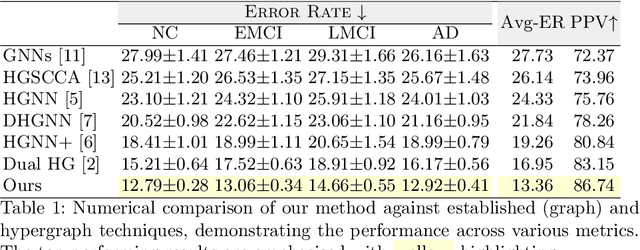
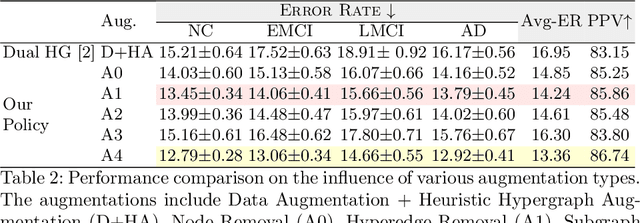
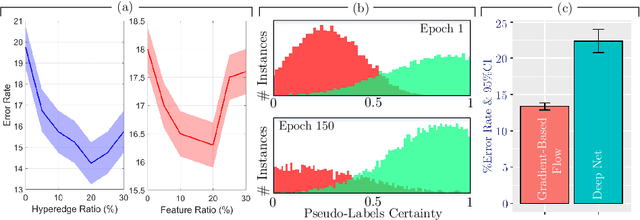
Abstract:Early detection of Alzheimer's disease's precursor stages is imperative for significantly enhancing patient outcomes and quality of life. This challenge is tackled through a semi-supervised multi-modal diagnosis framework. In particular, we introduce a new hypergraph framework that enables higher-order relations between multi-modal data, while utilising minimal labels. We first introduce a bilevel hypergraph optimisation framework that jointly learns a graph augmentation policy and a semi-supervised classifier. This dual learning strategy is hypothesised to enhance the robustness and generalisation capabilities of the model by fostering new pathways for information propagation. Secondly, we introduce a novel strategy for generating pseudo-labels more effectively via a gradient-driven flow. Our experimental results demonstrate the superior performance of our framework over current techniques in diagnosing Alzheimer's disease.
HGIB: Prognosis for Alzheimer's Disease via Hypergraph Information Bottleneck
Mar 18, 2023



Abstract:Alzheimer's disease prognosis is critical for early Mild Cognitive Impairment patients for timely treatment to improve the patient's quality of life. Whilst existing prognosis techniques demonstrate potential results, they are highly limited in terms of using a single modality. Most importantly, they fail in considering a key element for prognosis: not all features extracted at the current moment may contribute to the prognosis prediction several years later. To address the current drawbacks of the literature, we propose a novel hypergraph framework based on an information bottleneck strategy (HGIB). Firstly, our framework seeks to discriminate irrelevant information, and therefore, solely focus on harmonising relevant information for future MCI conversion prediction e.g., two years later). Secondly, our model simultaneously accounts for multi-modal data based on imaging and non-imaging modalities. HGIB uses a hypergraph structure to represent the multi-modality data and accounts for various data modality types. Thirdly, the key of our model is based on a new optimisation scheme. It is based on modelling the principle of information bottleneck into loss functions that can be integrated into our hypergraph neural network. We demonstrate, through extensive experiments on ADNI, that our proposed HGIB framework outperforms existing state-of-the-art hypergraph neural networks for Alzheimer's disease prognosis. We showcase our model even under fewer labels. Finally, we further support the robustness and generalisation capabilities of our framework under both topological and feature perturbations.
Multi-Modal Hypergraph Diffusion Network with Dual Prior for Alzheimer Classification
Apr 04, 2022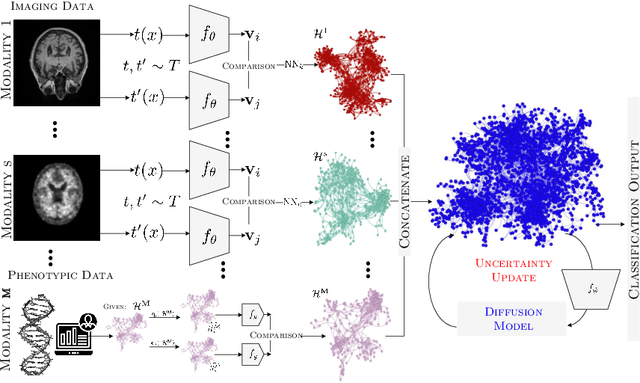

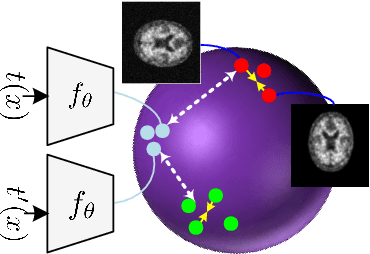
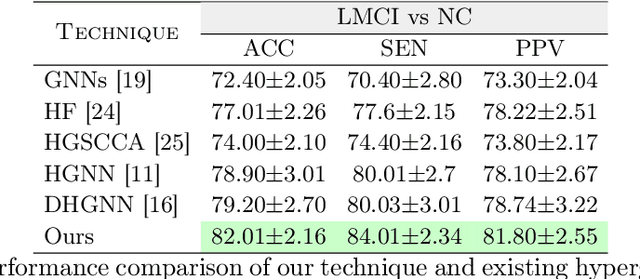
Abstract:The automatic early diagnosis of prodromal stages of Alzheimer's disease is of great relevance for patient treatment to improve quality of life. We address this problem as a multi-modal classification task. Multi-modal data provides richer and complementary information. However, existing techniques only consider either lower order relations between the data and single/multi-modal imaging data. In this work, we introduce a novel semi-supervised hypergraph learning framework for Alzheimer's disease diagnosis. Our framework allows for higher-order relations among multi-modal imaging and non-imaging data whilst requiring a tiny labelled set. Firstly, we introduce a dual embedding strategy for constructing a robust hypergraph that preserves the data semantics. We achieve this by enforcing perturbation invariance at the image and graph levels using a contrastive based mechanism. Secondly, we present a dynamically adjusted hypergraph diffusion model, via a semi-explicit flow, to improve the predictive uncertainty. We demonstrate, through our experiments, that our framework is able to outperform current techniques for Alzheimer's disease diagnosis.
CAFLOW: Conditional Autoregressive Flows
Jun 04, 2021



Abstract:We introduce CAFLOW, a new diverse image-to-image translation model that simultaneously leverages the power of auto-regressive modeling and the modeling efficiency of conditional normalizing flows. We transform the conditioning image into a sequence of latent encodings using a multi-scale normalizing flow and repeat the process for the conditioned image. We model the conditional distribution of the latent encodings by modeling the auto-regressive distributions with an efficient multi-scale normalizing flow, where each conditioning factor affects image synthesis at its respective resolution scale. Our proposed framework performs well on a range of image-to-image translation tasks. It outperforms former designs of conditional flows because of its expressive auto-regressive structure.
 Add to Chrome
Add to Chrome Add to Firefox
Add to Firefox Add to Edge
Add to Edge